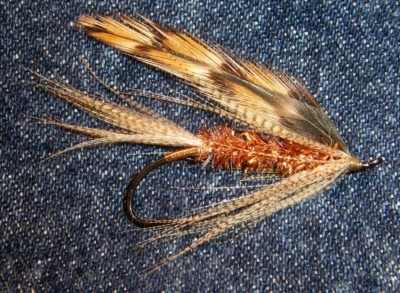
On The Fly
"Fly tying is a school from which we never graduate"
TYING NEWS
Morris Fruitman enjoyed teaching the Vets so much that he has volunteered to
put together a weekly tying program at the Dom in White City. The Southern Oregon Fly Tiers will
sponsor and donate materials for this program.
David Roberts was our guest tier at the September SOFT meeting in Gold Hill on
Tuesday the 9th. He demonstrated a couple of his favorite fall steelhead patterns in a
tie-along session. I encourage novice and experienced tiers alike to drop by the second Tuesday
of each month at 6 p.m. for a fun evening. We have plenty of room for everyone. If you are
interested in this educational experience, contact me and we will add your name to our e-mail
list. We can let you know who, when and what materials to bring.
 PATTERN OF THE MONTH - Copper Hilton, Spey Style
PATTERN OF THE MONTH - Copper Hilton, Spey Style
Hook: Daiichi 2441 or equivalent standard salmon/steelhead hook,
size 4-8.
Thread: Tan 6/0.
Tag: Flat copper tinsel, narrow.
Tail: Lemon Wood duck.
Body: Copper glitter chenille.
Collar Hackle: Lemon Wood duck, wet style.
Wing: A pair of Cree saddle hackle feathers.
Head: Tan thread.
Tying Instructions:
1) Start the thread one eye-width back from the eye. Lay down a thread layer to just above the
hook point.
2) Tie in the copper tinsel, wind it 5-6 turns back toward the hook bend and then forward to the
thread. Tie off and trim excess.
3) Select a Wood duck feather with barbs as long as the hook and remove the fuzz at the base of
the stem. Now, even the fibers at the bottom ¼ inch, cut them off on both sides of the stem and
measure them to one hook shank. Tie on these fibers to the top of the hook to form the tail.
Bind down the butts to the shank and advance the thread forward. Note: set aside the remaining
portion of the Wood duck feather, which will be used for the hackle.
4) Tie on the glitter chenille along the top of the hook to the base of the tail and advance the
thread forward to the front. Wind the chenille forward in touching turns. Tie off the chenille
and trim the excess. Be sure to leave plenty of room for the hackle, wing and head.
5) Tie on the Wood duck feather by the tip, fold and wind it two turns. Tie off and trim the
excess. Tie back on the fibers forcing them to sweep back over the body.
6) Select two Cree saddle hackle feathers and prepare them so that the tips reach just about to
the end of the tail. Tie them on, back to back, on top of the hook shank at about a 30-degree
angle. Tie off and trim.
7) Form a small, neat head, whip-finish and apply cement.
The Copper Hilton Spey is one of the many variations of the original Silver
Hilton, which was introduced after World War II in northern California on the Klamath and
Trinity Rivers. The originator has been long forgotten but the pattern is still popular
throughout the west for summer fish. Its success is attributed to the delicate hackle tip wings
that breath life into the fly when caught in river currents.
Drift these flies Spey-style. Cast upstream at roughly a 45-degree angle and
fish down and across the current. Allow the fly to hang in the current for a minute or two at
the end of the drift and slowly lift your rod tip. Sometimes this technique will result in a
crushing strike by a fish that has been watching your fly.
TYING TIPS
1) When you use hackle barbs for a tail, roll the fibers between your thumb and index finger to
make them fan out.
2) On this fly, one good Wood Duck feather should be enough to create both the tail and the
sparse Spey-style collar hackle.
The Hilton pattern is a proven winner. The Copper Hilton is a perfect example of how the tier
can change the material and color to suit his individual needs or changing conditions. Zero in
on a dozen or so patterns that you have confidence in, and after you learn the pattern concept
well you can customize all you want. Tie some up, give them a test flight and let me know how
you do.
Tie One On,
Dan Kellogg (you can contact me at FLYGUY@EZNORTHWEST.COM)